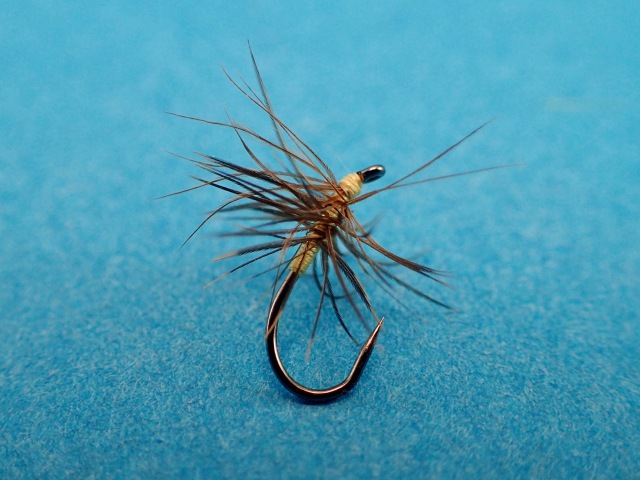We know that Leisenring was a big fan of Stewart’s spiders. He called them, “a deadly combination on every stream I have ever fished.” That’s one of the things that still attracts me to soft hackles — that a pattern so lethal on small Scottish rivers is just as effective here in the States. Here’s the second in a series of three, Stewart’s Red Spider.
Fresh out of landrail? No worries (or as they’d say in Stewart’s homeland, “Nae fears!”). You could use a brownish-red hen hackle or other similarly colored game bird. I like this solution best: starling wings dyed burnt orange. I bought them a few years ago from Mike Hogue at Badger Creek. Says Mr. Stewart:
 ~
~
Stewart’s Red Spider

Hook: 14-15 (from Leisenring). I used a Partridge SUD2 #14.
Silk: Yellow
Hackle: Landrail wing feather (I used dyed starling)
Body: Working silk
~
Tying Notes: Like the Black Spider, this pattern is widely interpreted. The silk body should cover only the front half of the shank. Select a feather with fibers about as long as the shank. To make a more durable fly, Stewart suggested twisting the hackle around a silk tag before winding. Here’s how I did that: Start the silk at the head, winding rearward. Leave a 3″ tag about 3/4 of the way down the body. Continue winding the working silk. At the halfway point of the shank, proceed back toward the head. When you get to the silk tag, tie in the feather at its tip, and continue winding your working silk toward the head. Now, twist the feather around the silk tag, taking care not to break the spine (starling is fragile!). Wrap the feather toward the head, 3-4 turns, preening the fibers so they don’t get covered (a bodkin or needle may help). Tie down the feather and whip finish.
In the 1800’s, Scots common law had only two offenses on the books. The first, “being English” and the second, “looking at someone in a funny sort of way” kept W.C. Stewart pretty busy. Thankfully, he found the time to develop these fly patterns. Very nice looking soft hackle and excellent instructions, thanks.
My pleasure, Bob. Try this last one with some white silk and a dun or white hackle and we’ve got a killer white fly emerger.
Woodcock looks good as a hackle.
Thanks for that, too. That makes sense.
[…] W.C. Stewart’s Red Spider […]